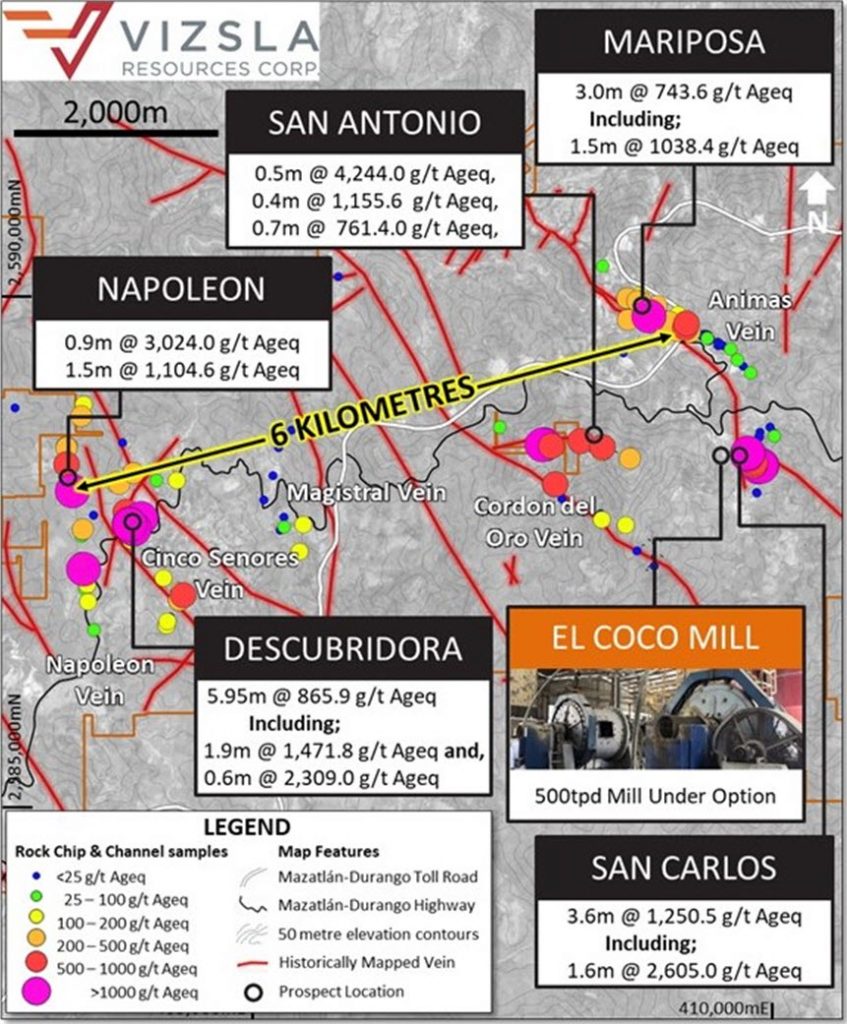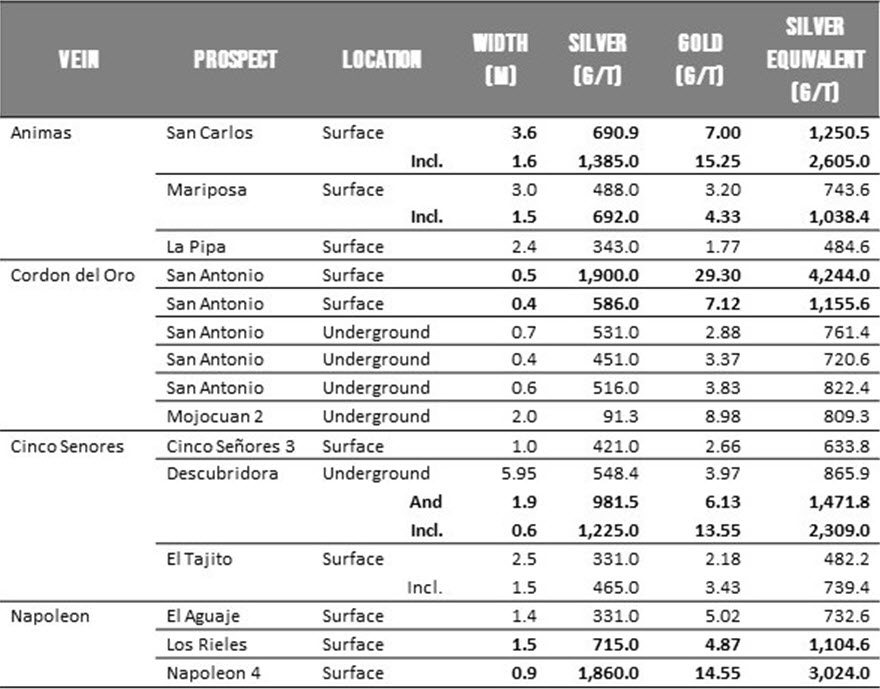NOT FOR DISTRIBUTION TO UNITED STATES NEWSWIRE SERVICES OR FOR DISSEMINATION IN THE UNITED STATES
Vancouver, British Columbia (November 12, 2019) – Vizsla Resources Corp. (TSX-V: VZLA) (“Vizsla” or the “Company”) is pleased to announce due diligence channel sampling results from five veins at the recently acquired Panuco precious metals district in Sinaloa, Mexico. The sampling locations are spread across the property and represent first pass sampling of the veins. Detailed sampling and mapping are ongoing ahead of a maiden drill program.
Sampling Highlights
- 3,024 grams per tonne (g/t) silver equivalent (1,860.0 g/t silver and 14.55g/t gold) over 0.9 metres at Napoleon 4 – Napoleon Vein
- 4,244 g/t silver equivalent (1,900.0 g/t silver and 29.30 g/t gold) over 0.5 metres at San Antonio – Cordon del Oro Vein
- 1,250 g/t silver equivalent (690.9 g/t silver and 7.00 g/t gold) over 3.6 metres at San Carlos – Animas Vein including;
- 2,605 g/t silver equivalent (1,385.0 g/t silver and 15.25 g/t gold) over 1.6 metres
- 866 g/t silver equivalent (548.4 g/t silver and 3.97 g/t gold) over 5.95 metres at Descubridora – Cinco Señores Vein including;
- 1,472 g/t silver equivalent (981.5 g/t silver and 6.13 g/t gold) over 1.9 metres, and
- 2,309 g/t silver equivalent (1,225.0 g/t silver and 13.55 g/t gold) over 0.6 metres
Note: All numbers are rounded. Silver equivalent (Ageq) is calculated by multiplying the gold grade by 80 and adding it to the silver grade. This calculation estimates 100% recovery of both metals. Widths are estimated to represent true widths.
“These sample results demonstrate the widespread nature of very high-grade mineralization across the Panuco project with greater than 1,000 g/t silver equivalent results obtained from six different prospects on four of the five veins sampled-to-date.” commented Charles Funk, Vice President of Exploration for Vizsla. “The Napoleon vein, the Corden del Oro vein and the southern half of the Cinco Señores vein, including the Descubridora Mine, have never been drilled making these particularly exciting new targets to add to the more advanced mined areas along the Animas Vein.”

Exploration Program
The Company, through its wholly-owned subsidiary Canam, commenced a mapping and sampling program to better understand mineralization at Panuco. The program has now visited five of the major vein corridors with widespread mineralization sampled on four. Systematic infill sampling and detailed mapping will now be completed beginning with the Animas vein while prospecting will continue on other veins known to be of interest on the project. Further, a detailed structural geological interpretation is planned for November to help generate more precise drill targets at each prospect.
Veining across the property shows remarkably similar vein textures with most veins displaying a well developed but lower grade white crystalline to sacchoridal quartz vein and a less continuous high-grade grey crystalline quartz breccia vein with patchy to abundant argentite and pyrite. A significant crackle breccia occurs as a selvedge to veins. Veins locations are largely controlled by through-going, clay bearing, faults up to 2.5 metres wide that form the footwall or hangingwall of veins and contain milled fragments of vein and country rock.

Silver equivalent (Ageq) is calculated by multiplying the gold grade by 80 and adding it to the silver grade. This calculation estimates 100% recovery of both metals. Widths are estimated to represent true widths.
Animas Vein
The Animas Vein is the most advanced structure on the project with mining by locals in progress over a 2.8 kilometre strike length. The vein includes several mines including San Carlos (see previous news release, 7th of November 2019), Clemens-El Muerte, La Pipa, Mariposa, San Martin, and Brecha Animas along the trend of the vein.
Cordon del Oro Vein
The Cordon del Oro Vein and associated splays have no recorded history of drilling. Local miners have exploited several prospects along the corridor including Cabriza, Mojocuan 1 and 2 and San Antonio.
The area is located at a higher elevation and is known for elevated gold relative to silver. The ratio of gold to silver is commonly zoned in epithermal systems in Mexico and Vizsla is exploring the possibility that this indicates a shallower level of erosion with a greater vertical extent of vein preserved beneath the surface.
San Antonio is an east-west trending splay vein that has multiple small-scale mines and is a narrow vein with consistent high-grade mineralization over 650 metres of strike. Detailed mapping along this vein is in progress to define areas where this structure dilates into potential ore chutes.
Cinco Señores Vein
Multiple veins make up the Cinco Señores corridor with workings and deposits along the trend including the Tajitos, Santa Ana, Descubridora and the flat lying La Colorada deposit. Sampling highlights the importance of vein intersections with a blowout zone identified at Descubridora that represents an attractive drill target.
Napoleon Vein
The veins at Napoleon have never been drilled despite some mines along the trend seeing significant production and multiple levels of underground development. Silver equivalent grades in excess of 500 grams per tonne occur over 1 kilometre of strike extent. A number of splay or cross-cutting veins are noted at adit entrances and infill mapping and sampling will focus on understanding ore-controls prior to drilling.
About the Panuco project
Vizsla has an option to acquire 100% of the newly-consolidated 9,386.5 Ha Panuco district in southern Sinaloa, Mexico, in the Municipio of Concordia. The property covers the historic Panuco-Copala silver and gold mining district that has been in production for over 450 years. The option allows for the acquisition of a mill, mines, tailings facilities, roads, power and permits.
The district contains intermediate to low sulfidation epithermal silver and gold deposits related to siliceous volcanism and crustal extension in the Oligocene and Miocene. Host rocks are mainly Oligocene ignimbrites and volcanic rocks, continental volcanic and sedimentary rocks correlated to the Tarahumara Formation, and marine volcanic and sedimentary rocks of the underlying Guerrero Composite Terrane and its metamorphic basement.
Qualified Person
The scientific and technical information in this news release has been prepared in accordance with the Canadian regulatory requirements set out in National Instrument 43-101 (Standards of Disclosure for Mineral Projects) and reviewed and approved on behalf of the Company by Michelle Robinson, MASc. P.Eng., a Qualified Person as defined by NI 43-101 (the “Qualified Person”). Rock samples discussed in this New Release were prepared by the Company and assayed at ALS according to the procedures detailed in News Release of 7 November 2019. Control samples, including field duplicates, pulp duplicates, standard reference pulps and blanks, were inserted into the sample stream. Any QA/QC issues were identified and re-analyzed as required as part of the analytical process.
Contact Information: For more information and to sign-up to the mailing list, please contact:
Michael Konnert, President and Chief Executive Officer
Tel: (604) 838-4327
Email: [email protected]
Neither TSX Venture Exchange nor its Regulation Services Provider (as that term is defined in policies of the TSX Venture Exchange) accepts responsibility for the adequacy or accuracy of this release.
Source: Vizsla Resources Corp.





















